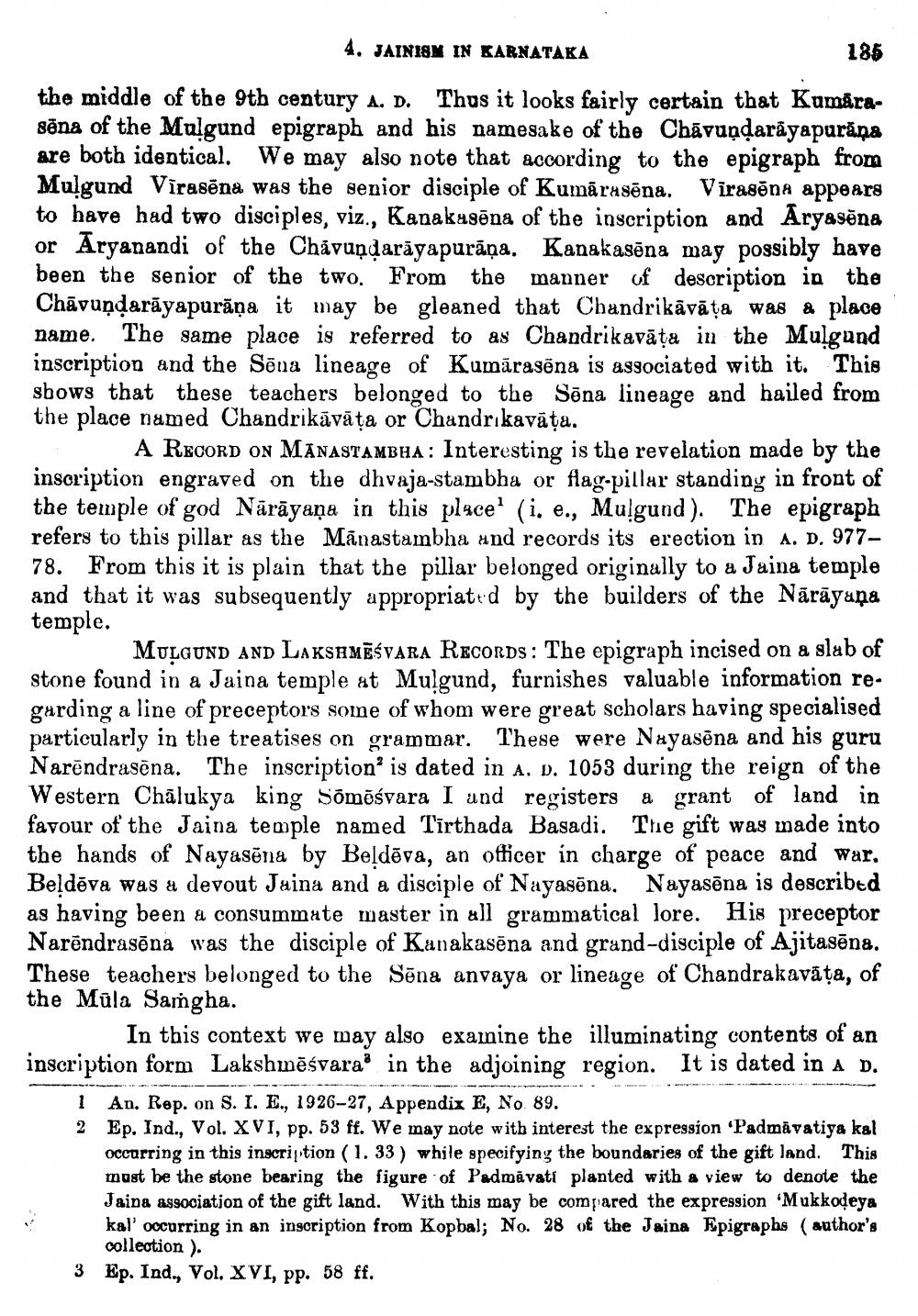________________
4. JAINI8N IN KARNATAKA
186 the middle of the 9th century A. D. Thus it looks fairly certain that Kumārasõna of the Mulgund epigraph and his namesake of the Chāvuņdarāyaparāņa are both identical. We may also note that according to the epigraph from Mulgund Virasēna was the senior disciple of Kumārusēna. Vīrasēna appears to have had two disciples, viz., Kanakusõna of the inscription and Aryasõna or Aryanandi of the Chávuņdarāyapurāņa. Kanakasēna may possibly have been the senior of the two. From the manner of description in the Chāvuņdarāyapurāņa it may be gleaned that Chandrikāvāta was a place name. The same place is referred to as Chandrikavāta in the Mulgund inscription and the Söna lineage of Kumārasēna is associated with it. This sbows that these teachers belonged to the Sõna lineage and hailed from the place named Chandrikāvāța or Chandrikavăța.
A RECORD ON MANASTAMBHA: Interesting is the revelation made by the inscription engraved on the dhvaja-stambha or flag-pillar standiny in front of the temple of god Nārāyaṇa in this place (i, e., Mulgund). The epigraph refers to this pillar as the Mānastambha and records its erection in A. D. 977– 78. From this it is plain that the pillar belonged originally to a Jaina temple and that it was subsequently appropriattd by the builders of the Nārāyana temple.
MULGUND AND LAKSAMĒŚVARA RECORDS: The epigraph incised on a slab of stone found in a Jaina temple at Mulgund, furnishes valuable information regarding a line of preceptors some of whom were great scholars having specialised particularly in the treatises on grammar. These were Nayasēna and his guru Narēndrasēna. The inscription' is dated in A, p. 1053 during the reign of the Western Chālukya king Sõmāśvara I und registers a grant of land in favour of the Jaina temple named Tirthada Basadi. The gift was made into the hands of Nayasõna by Beldēva, an officer in charge of peace and war, Beļdēva was a devout Juina and a disciple of Nayasēna. Nayasēna is described as having been a consummute master in all grammatical lore. His preceptor Narēndrasēna was the disciple of Kanakasēna and grand-disciple of Ajitasēna. These teachers belonged to the Sēna anvaya or lineage of Chandrakaväta, of the Mula Samgha.
In this context we may also examine the illuminating contents of an inscription form Lakshmēśvara in the adjoining region. It is dated in a D.
1 An. Rep. on S. I. E., 1926-27, Appendix E, No. 89. 2 Ep. Ind., Vol. XVI, pp. 53 ff. We may note with interest the expression 'Padmavatiya kal
occurring in this inscription (1. 33 ) while specifying the boundaries of the gift land. This must be the stone bearing the figure of Padmavati planted with a view to denote the Jaina association of the gift land. With this may be compared the expression Mukkodeya kal' occurring in an inscription from Kopbal; No. 28 of the Jaina Epigraphs (author's
collection ). 3 Ep. Ind., Vol. XVI, pp. 58 ff.




